Mondraker Dune
Wheel Size: 29’’ front / 27.5’’ rear
Travel: 165 mm rear / 170 mm front (Dune RR / R), 180 mm front (Dune XR)
Geometry Highlights:
- Sizes Offered: S, M, L, XL
- Headtube Angle: 64° (Dune RR / R), 63.6° (Dune XR)
- Reach: 485 mm (Size Large, Dune RR / R) / 480 mm (Size Large, Dune XR)
- Chainstay Length: 445 mm
Frame Material: Carbon fiber
Prices:
- Dune XR Frameset w/ Ohlins TTX22m.2 shock: $6,799 USD
- Complete bikes: $7,999 to $11,999
Blister’s Measured Weight: 43.6 lb / 19.7 kg (Dune XR, size Large)
Reviewers:
- Dylan Wood: 5’10.5”, 160 lbs / 179 cm, 72.5 kg
- Simon Stewart: 6’, 170 lb / 183 cm, 77.1 kg
Test Location: Colorado
Test Duration: 4 months
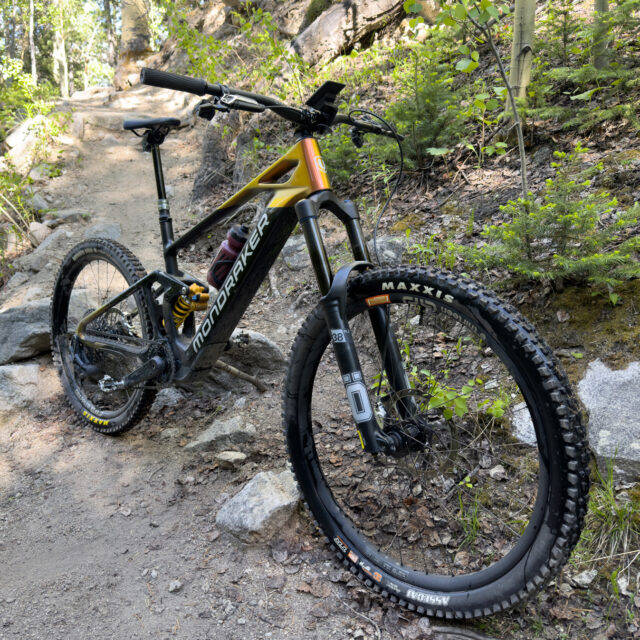
Intro
We are seeing a lot of activity in the eMTB space, and Mondraker has joined the party with their new Dune. Riders might recall the Dune as Mondraker’s longstanding Enduro bike, first released back in 2009, but given Mondraker’s limited US availability until just earlier this year, they have been a rare sight on the trails around here.
For 2024, the Dune’s Enduro focus continues, but now with the addition of a motor — the Bosch Performance Line SX. With claimed weights under 44 lbs / 20 kg, the 165 mm travel Dune is big on travel and low on weight. Let’s dig into the new Dune to see what Mondraker has cooked up.
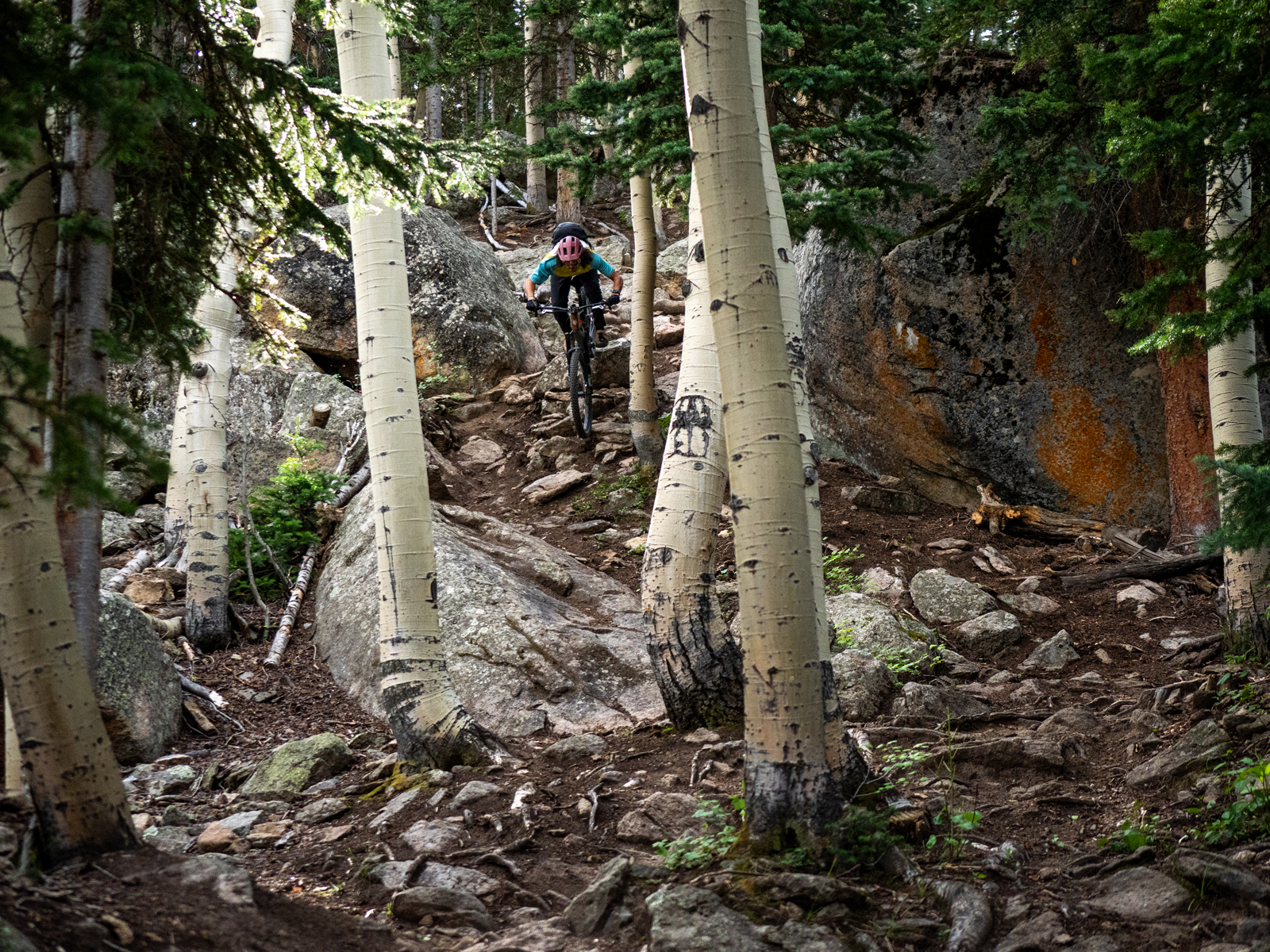
The Frame
Mondraker’s bikes have a distinct design language, with their unmistakable void just behind the head tube as well as their Zero suspension system. Mondraker has updated the dual-link Zero layout across a number of their recently updated bikes, claiming that the updated design brings a lower center of gravity and allows for a stiffer and lighter rear triangle.
The Dune is available with mixed wheels and in carbon fiber only — specifically Mondraker’s Stealth Air Carbon, their most advanced (and expensive) carbon fiber layup. The upper link that drives the shock is also a single carbon fiber unit. All that carbon fiber means that the bare frame without shock, motor or battery weighs just 2.65 kg, or about 5.8 lbs.
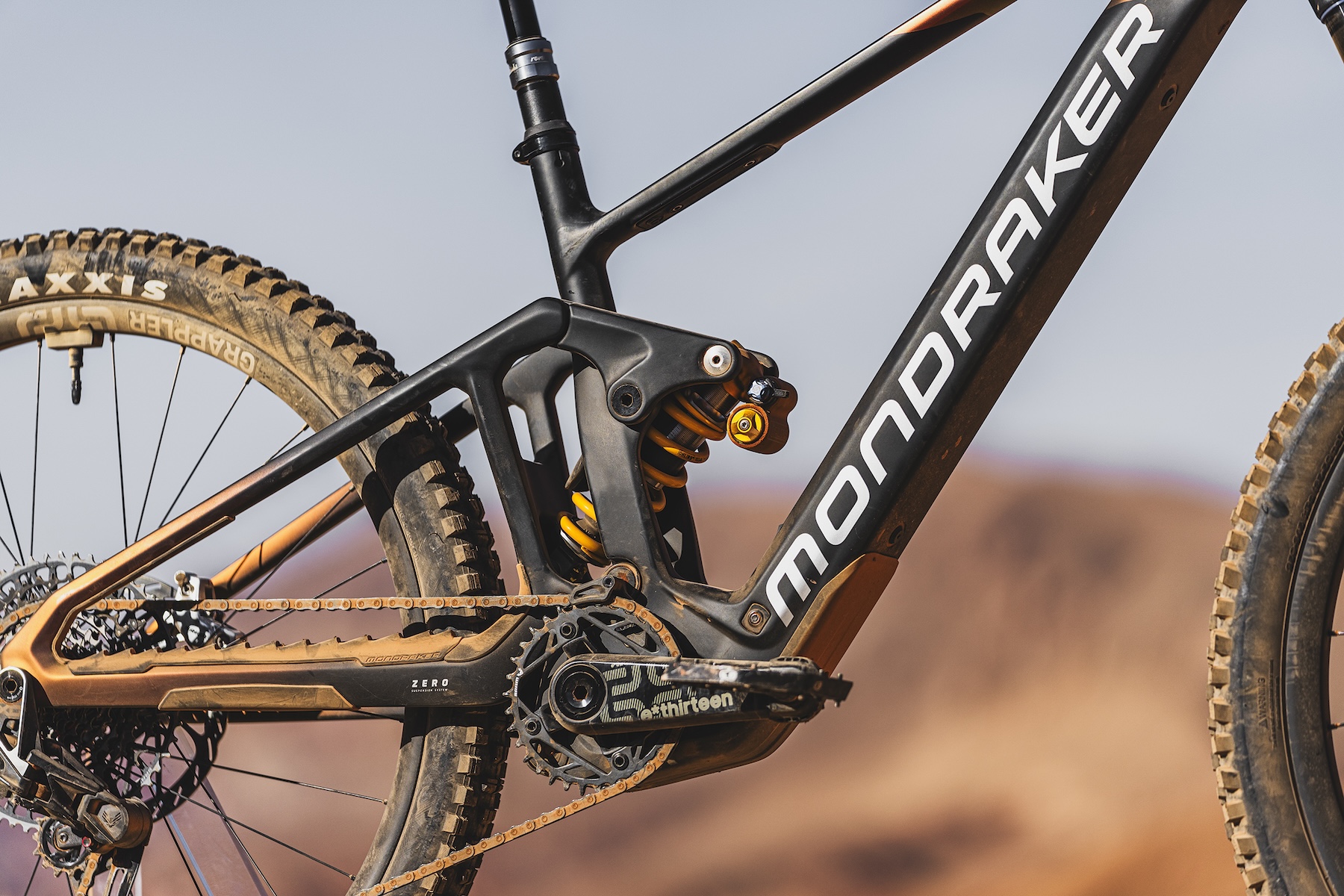
Unfortunately, it appears that Mondraker has opted to stick with headset cable routing on the new Dune, which means some extra fettling when it comes to brake swaps, headset servicing, and the like.
Other frame details included molded rubber frame protection on the rear triangle, a motor bash guard, an integrated mudguard to protect the shock from wheel spray, ample space for a water bottle, and a magnetic Fidlock accessory mount under the top tube.
Drive System
Mondraker has designed the Dune around Bosch’s Performance Line SX motor. As the lightweight motor in Bosch’s range, the Performance Line SX delivers a maximum 55 Nm of torque and 600W of peak power. That peak power rating is particularly impressive and matches many full power motors, including Bosch’s Performance Line CX. Bosch’s System Controller is integrated into the top tube, and the Mini Remote and Kiox 500 display are fitted to the handlebar.
The Dune’s battery is a 400Wh Bosch CompactTube 400 battery and is noted as being internal and removable, though the ease of removal will have to be verified once we get a chance to ride the Dune for ourselves. The Dune is also compatible with Bosch’s PowerMore 250 extender, which bolts onto the water bottle bosses and adds 250Wh of range along with a 1.5 kg / 3.3 lbs weight penalty.
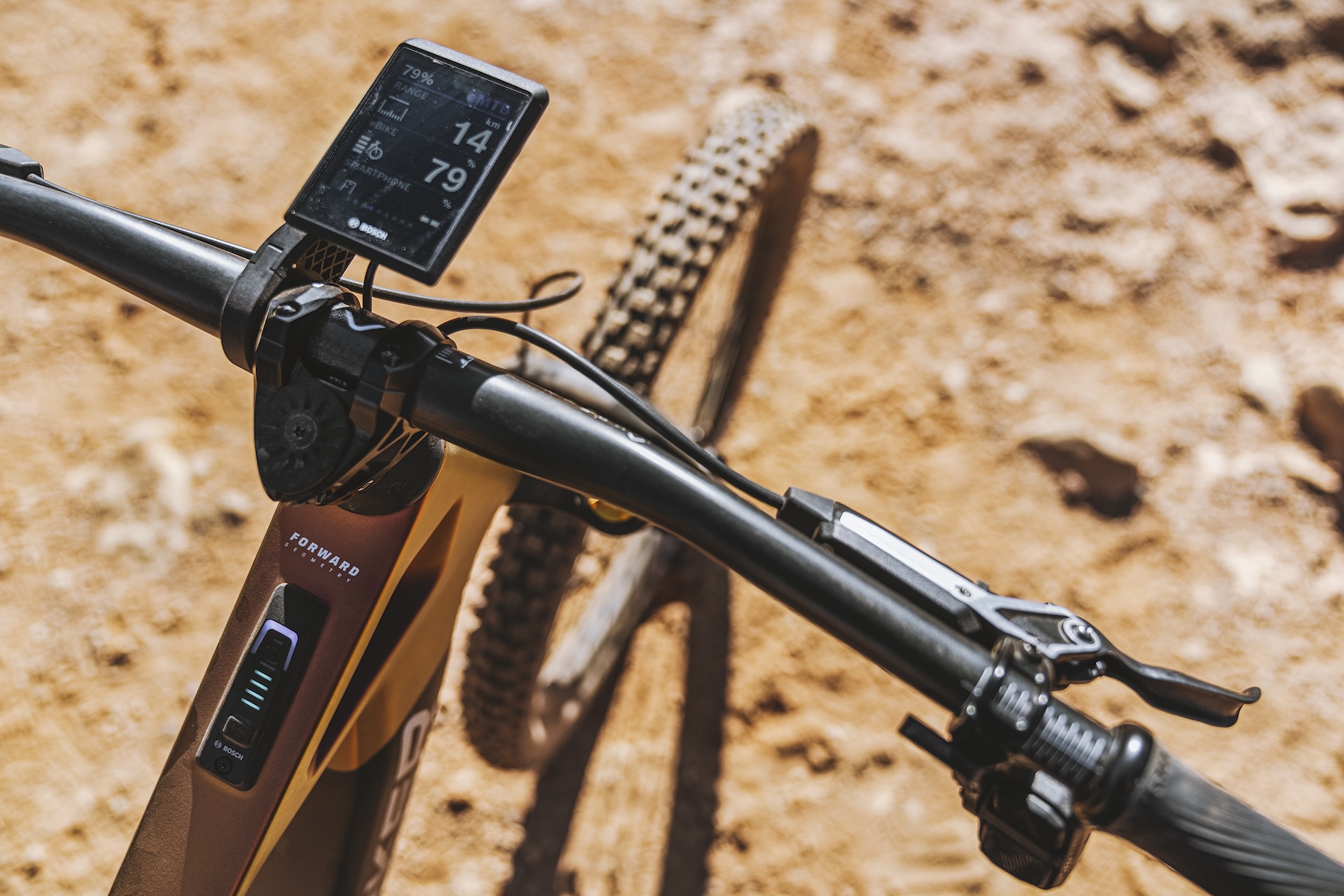
Fit & Geometry
Mondraker is offering the Dune in four sizes, from Small to XL. An early innovator around long reaches and short stems with their Forward Geometry concept, Mondraker’s latest geometry figures seem a lot less radical by modern standards. For the Dune RR and R models with a 170 mm fork, the headtube angle sits at 64° across sizes, with the Large getting a fairly typical 485 mm reach. The Dune XR gets a longer 180 mm travel fork, which slackens the headtube angle to 63.6° and shortens the reach slightly to 480 mm.
The effective seat angle is a fairly steep 77.5° on the Dune RR / R and 77.1° on the Dune XR. The actual seat angle, however, is 73.6° which means that the seat angle may feel slacker than the published effective seat angle for folks running a higher-than-average seat position on a given size. Mondraker’s geometry chart unfortunately doesn’t include the reference seat height for that effective seat angle figure.
All sizes get the same 445 mm chainstays, which could feel a bit ungainly on the Small where they exceed the 440 mm reach figure, but should afford a nice balance on the larger sizes. Stack figures are quite high across the board, with the Large sitting at 648 mm on the Dune RR / R, and 652 mm on the Dune XR, which should make for a confident, tall front end on steeper terrain.
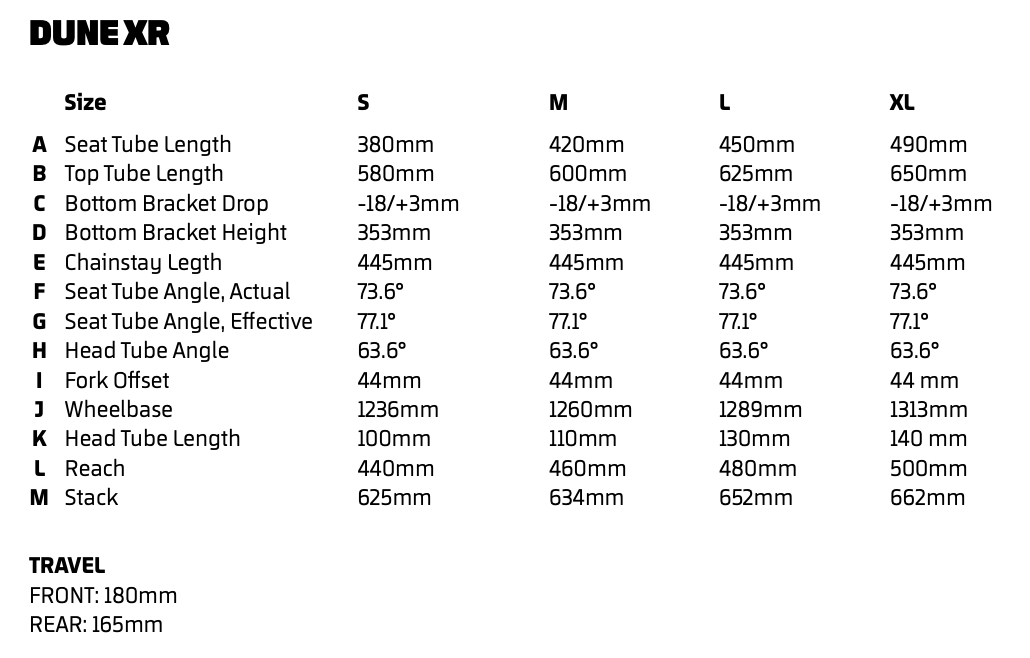
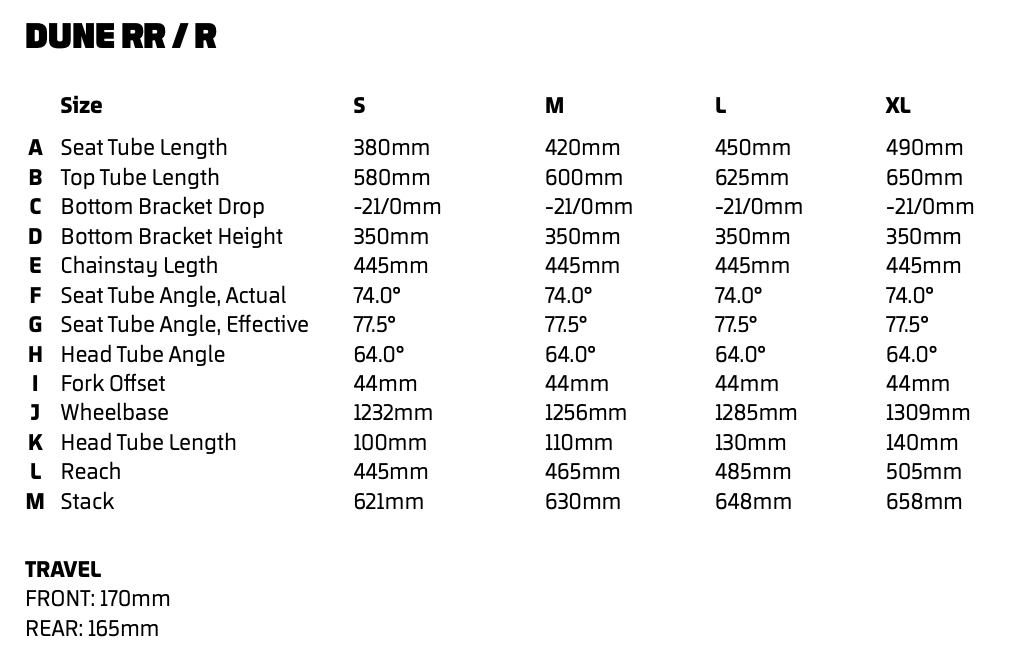
The Builds
The Dune comes in three trim levels, from the base model R to the top step Dune XR.
Positioned as a “Super Enduro” bike by Mondraker, all three models get 38 mm stanchion forks, with the base Dune R model getting a Fox 38 Performance while the two higher spec builds get the Ohlins RXF 38 M.2 — a fork that we are big fans of here at Blister. The Dune XR gets bumped to 180 mm of fork travel where the Dune RR and R get 170 mm, and the XR gets a coil-sprung Ohlins TTX22M.2 shock while the Dune RR and R are fitted with air shocks (the Ohlins TTX Air and Fox Float X Performance, respectively).
The Dune XR and RR both get electronic shifting via SRAM’s Transmission (XO on the XR, GX on the RR), while the Dune R sticks with a mechanical SRAM drivetrain with a combination of GX and NX parts. All three build specs get the same Maxxis Assegai MaxxGrip front tire in an EXO+ casing, with Minion DHR II MaxxTerra DoubleDown rear tires. While we would prefer to see DoubleDown casings on both ends, Mondraker has done better than most with casing and compound selection here.
All the builds see a fairly hefty dose of Mondraker’s in-house Onoff components and come with a stubby 30 mm stem. Dropper post lengths are a bit shorter than we’d like to see, though the interrupted seat tube presumably makes that tough — the size Large, for example, gets a 140–170 mm adjustable dropper, which is pretty short by modern standards.
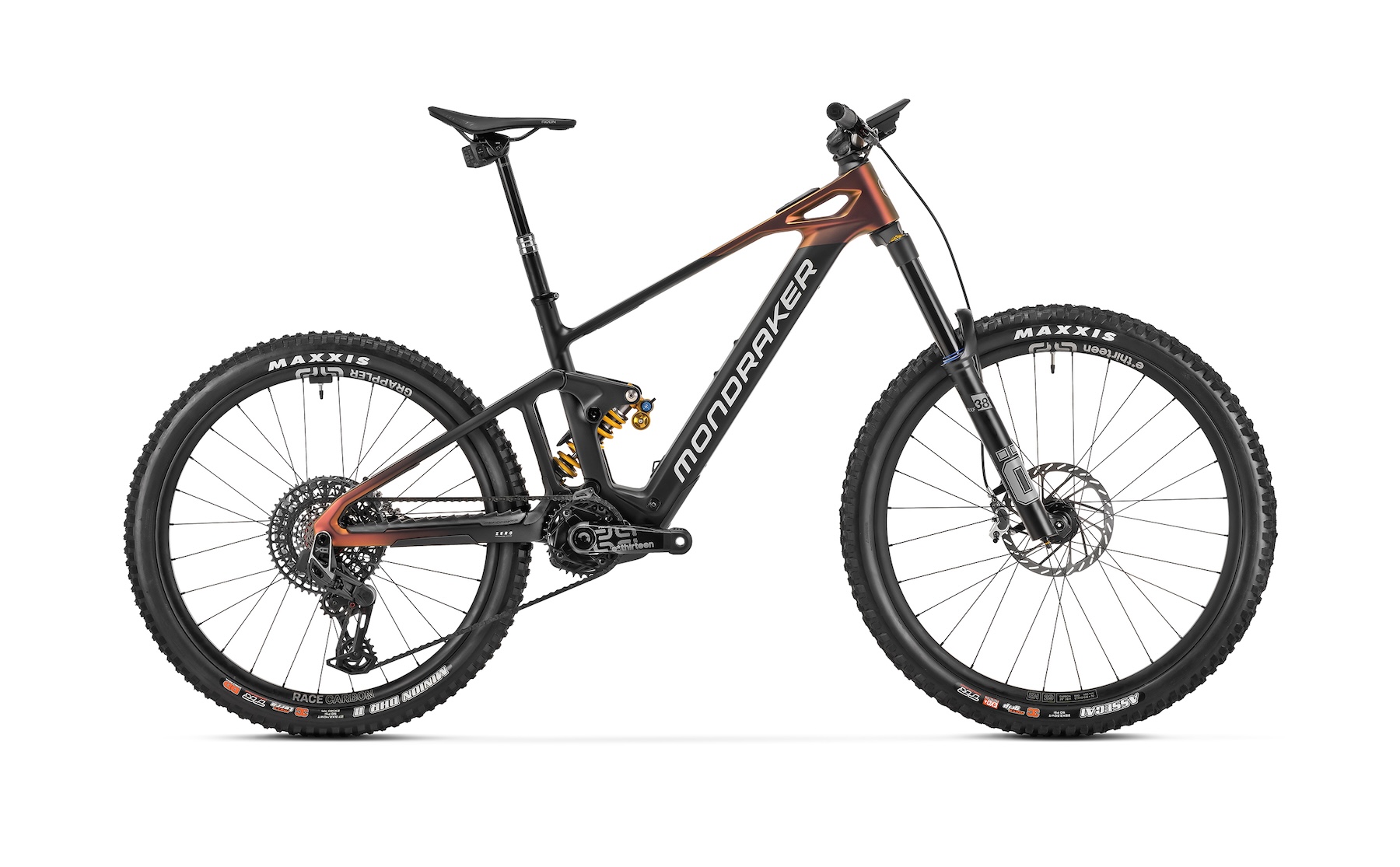
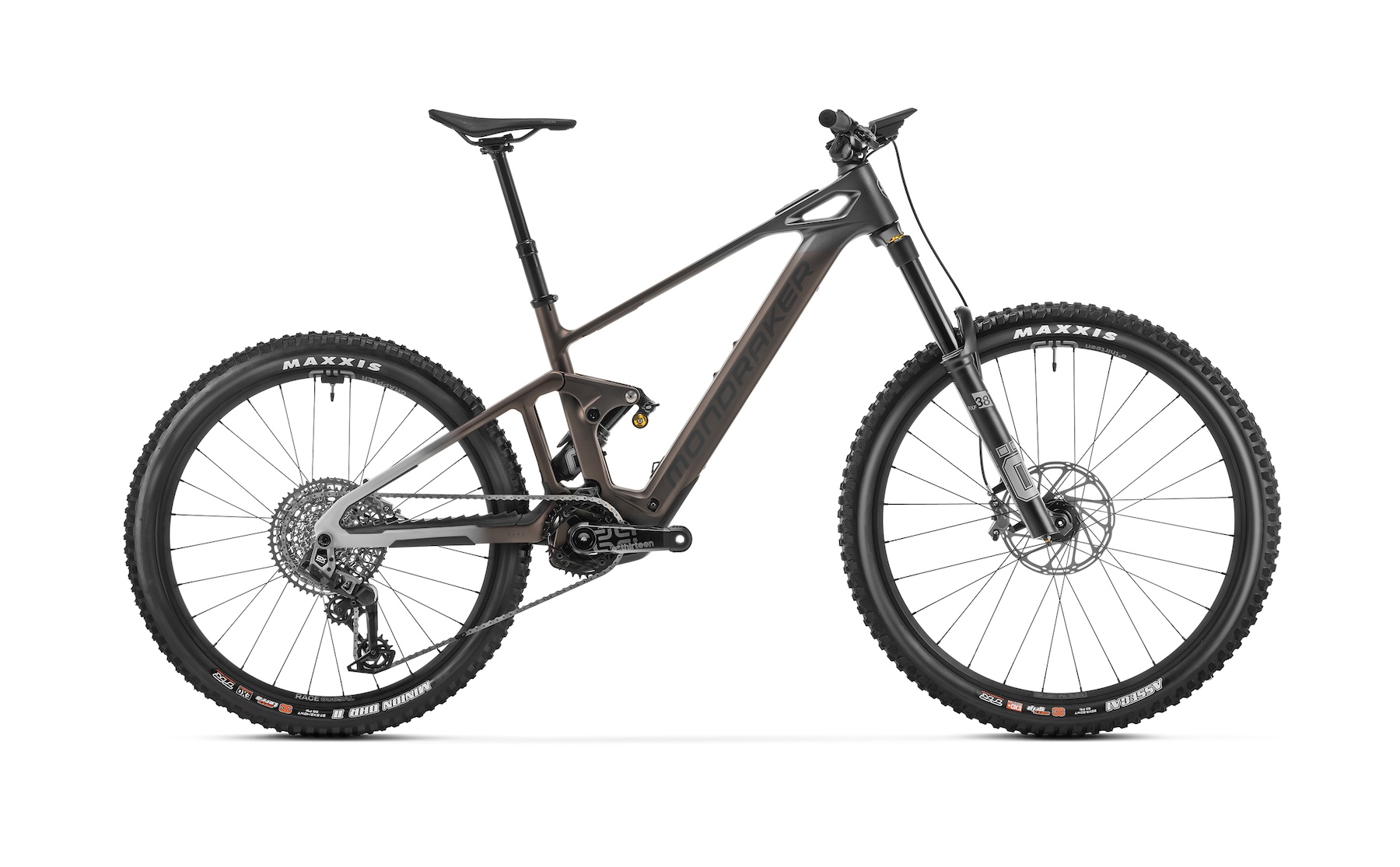
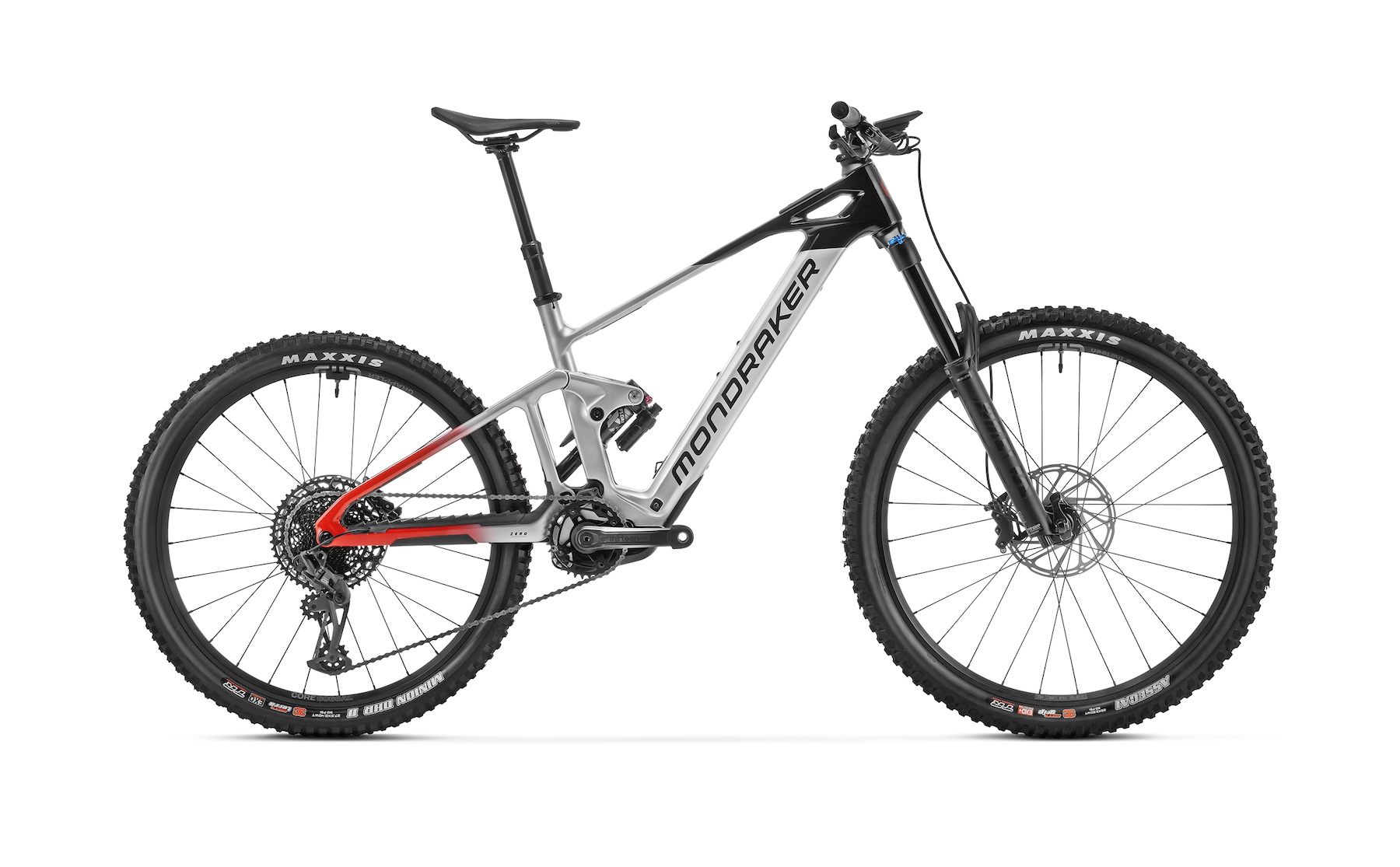
Full build specifications are below. In addition to the complete builds, Mondraker also offers the top-step Dune XR as a frameset for $6,799 USD.
- Drivetrain: SRAM GX / NX Eagle
- Brakes: SRAM DB8 (200 mm rotors)
- Fork: Fox 38 Performance Grip (170 mm)
- Shock: Fox Float X Performance
- Wheels: e*thireen Grappler Core
- Dropper Post: Onoff Pija (S: 95–125 mm; M: 120–150 mm, L: 140–170 mm, XL: 170–200 mm)
- Drivetrain: SRAM GX Transmission
- Brakes: SRAM Code Bronze Stealth (200 mm rotors)
- Fork: Ohlins RXF 28 M.2 (170 mm)
- Shock: Ohlins TTX Air
- Wheels: e*thirteen Grappler Race
- Dropper Post: Onoff Pija (S: 95–125 mm; M: 120–150 mm, L: 140–170 mm, XL: 170–200 mm)
- Drivetrain: SRAM XO Transmission
- Brakes: SRAM Code Ultimate Stealth (200 mm rotors)
- Fork: Ohlins RXF 38 M.2 (180 mm)
- Shock: Ohlins TTX22M.2 (S: 343 lbs spring, M: 411 lbs spring, L: 457 lbs spring, XL: 502 lbs spring)
- Wheels: e*thirteen Grappler Race Carbon
- Dropper Post: RockShox Reverb Stealth AXS (S: 125 mm; M: 150 mm, L–XL: 170 mm)
FULL REVIEW
The Mondraker Dune XR brings something a little different to the table. Usually, eMTBs that have as much travel (165 mm rear / 180 mm front) are full-power eMTBs, but the Dune XR pairs a downhill-focused platform with Bosch’s light-assist SX drive system. We’ve spent the last few months riding the Dune XR all over Colorado to see how it all comes together. Before we dive into the Dune XR into particular, check out our Head-to-Head video, where we compare it against another lightweight, longer-travel eMTB, the Cannondale Moterra SL:
Fit & Sizing
Dylan Wood (5’10.5”, 160 lbs / 179 cm, 72.5 kg): At my height, I’m almost right in the middle of Mondraker’s recommended sizing for the Large Dune XR. On the bike, that feels accurate — I got along with the fit of the Dune XR quite nicely. It has a comfortable seated pedaling position, but plenty of room to move around when out of the saddle. Its reach of 480 mm on the size Large is right inside my preferred range of ~475-485 mm, and feels really ideal for me. The Dune XR has an effective seat tube angle of 77º for every size, and while I might want it to be a bit steeper on an unpowered MTB, I generally don’t mind having slightly slacker seat tube angles on eMTBs with a motor to help out on the way up.
When climbing, I found the Dune comfortable on a wide range of climbs. On flatter roads, when staying in the saddle, the Dune XR put me in an athletic, yet sustainable position. As the climb gets steeper, it’s easy to shift your weight forward on the Dune, making sure that the front tire has enough weight on it. Outside of the saddle, there is plenty of room to move around without feeling stretched out.
My only gripe with the sizing of the Dune XR comes from a combination of a long-ish seat tube, and the relatively high stack of the RockShox Reverb AXS seatpost. I have relatively long legs for my height, and with my ideal seat height set on the Dune XR (765 mm from the center of the bottom bracket to the top and center of the saddle), there’s only just over 2 cm of room for me to lower the 170 mm dropper post. This might cause those with shorter legs or those looking to size up to ride their preferred size of the Dune XR, to have to swap in a shorter stack height dropper post.
Simon Stewart (6’, 170 lb / 183 cm, 77.1 kg): Like Dylan, I land in the middle of Mondraker’s recommended sizing for the size Large, and looking over the geometry numbers I had little doubt that it would be the right choice for me. Once the Dune XR arrived, my fit assumption was confirmed since it fit really well out of the box.
I share the same sentiment as Dylan regarding the very little room to move the dropper post down for riders with shorter inseams than us (we have almost identical seat heights), and personally, I would prefer a longer than 170 mm dropper post that is spec’d on the size Large (and XL). I mentioned in the Flash review that I would measure seat post insertion to determine if a longer travel post would fit — but due to the interrupted seat tube (for shock placement), and only 20 mm of space between the dropper post collar and seat tube collar, I had my doubts.
The Large Dune XR seatpost insertion depth measures 248 mm, and when running the numbers with my saddle height in OneUp’s Dropper Post Length Calculator, it looks like a 180 mm OneUp dropper post will squeeze in, barely.
The rest of the fit is spot on for me. The reach is smack in the middle of my preferred range (same as Dylan’s), and I love the high stack height (652mm, size L). Because I don’t think getting 10 mm of additional dropper post travel is worth changing seat posts, the Dune XR didn’t require any part swapping to fine-tune the fit.
Climbing
Dylan: The Dune XR provides a very traction-rich climbing experience, and when mixed with the light-yet-mighty Bosch SX drive system, the Dune XR is a very capable climber.
It’s clear that efficiency is not the main goal of the Dune XR’s suspension design. Rather, this bike does a very good job of staying glued to the ground, its rear tire providing almost absurd levels of traction. The rear suspension does an excellent job of keeping the rear wheel engaged to the trail. With an unpowered MTB, that would likely result in a very sluggish bike, but since the Dune XR is equipped with the light-assist Bosch SX drive system that is a category leader for how much power it provides, the Dune XR can easily power up just about any climb without requiring much effort from the rider.
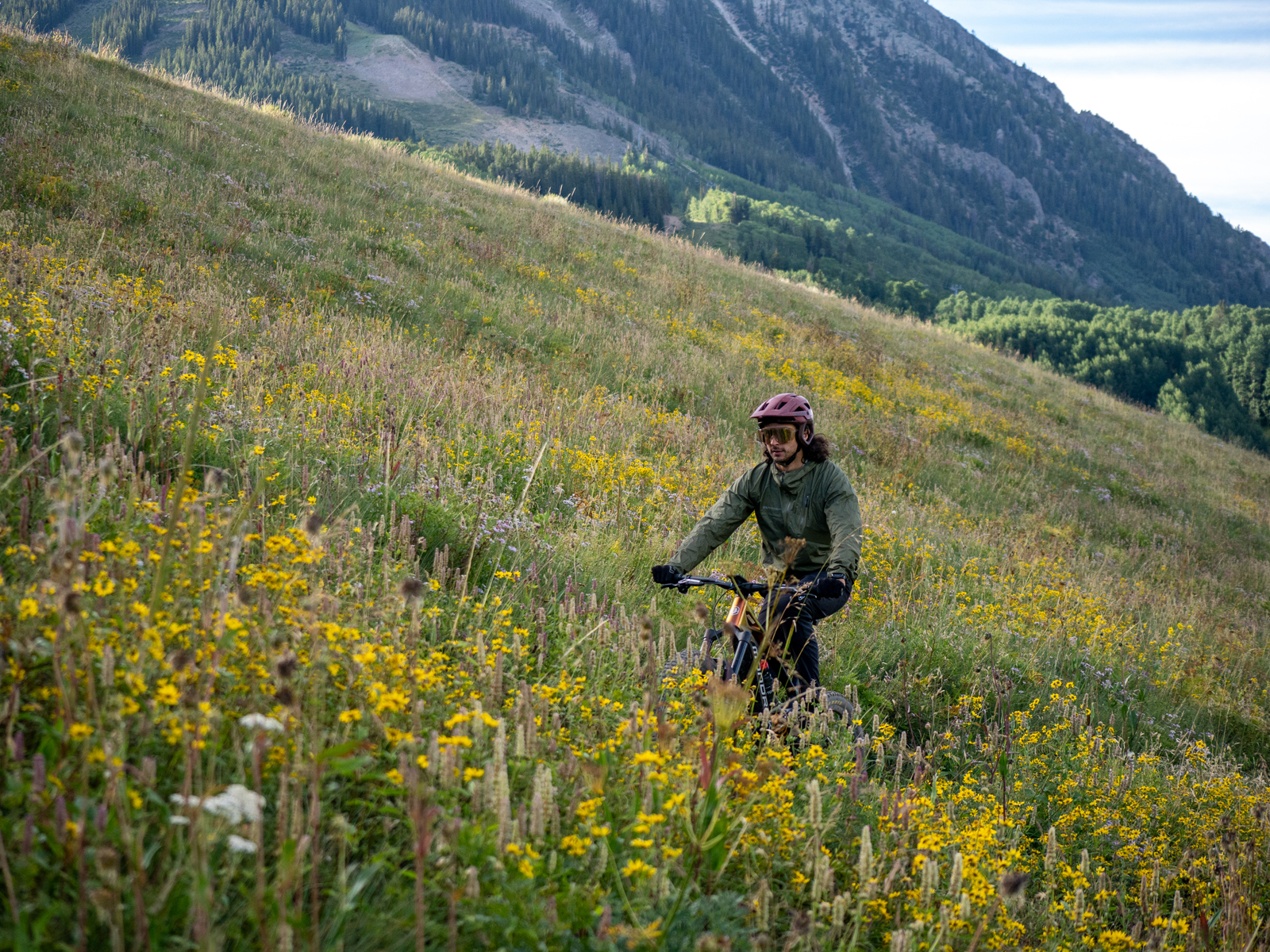
The Dune XR can get up just about anything thrown at it, with its limitations only found on extremely steep climbs. In those situations, I wished its seat tube angle was a bit steeper, allowing the rider to get more weight forward on the bike. The only times I found myself unable to clean a climb on the Dune XR were when I couldn’t get forward enough and could not control the front end of the bike, and on extremely steep trails when the Bosch SX system (and I) couldn’t deliver enough power.
The Dune XR is not the quickest eMTB out there. Not only is it a light-assist bike, but it’s not an especially light one, with a burly rear tire and coil shock out back, making it feel less sprightly than other Bosch SX-equipped bikes we’ve tried, such as the lightweight, short-travel Norco Fluid VLT 130. But, with how much traction it provides, I think it’s a worthy tradeoff, especially because of how much this bike enjoys steep, gnarly terrain.
Simon: Thanks to the fit being just about perfect for me, I immediately felt comfortable climbing on the Dune XR. The seated pedaling position offers room to adjust your weight bias to suit the steepness of the terrain, and I didn’t really have the same issues Dylan had keeping the front wheel tracking, but I do agree that the Bosch SX motor runs out of grunt when the trail gets really steep.
Riding an eMTB on steep, loose, technical climbs is often a game of managing the motor output to maintain traction. The Dune XR, however, is an exception, because even in “Turbo” mode on the steepest climbs I found it damn near impossible to break the rear wheel loose. It made me wonder how it would do with a full-power motor like the Bosch CX — don’t get me wrong, I appreciate what the Dune XR’s low weight (the lightweight SX motor being a main contributor) does for its handling, but at the same time, I can’t help thinking how it would be an unstoppable technical climber with the extra torque of a full-power motor. It’s worth noting that Mondraker offers the Level XR, which has similar travel and geometry to the Dune XR, but with an aluminum frame and full-power Bosch CX motor.
The Dune XR is tractor-like in its climbing performance. It’s definitely not the fastest uphill, but its incredibly well-composed, traction-rich suspension amplifies the Bosch SX motor’s smooth power delivery to keep the rear wheel clawing at the ground. The Dune XR impressed us by how well it handled technical climbing — it only struggled when things got really steep, and that was from the SX motor just not having as much torque (55 Nm) as full-power motors (~85 Nm).
It is fairly clear that the Dune XR is a downhill-focused eMTB, and considering much of its climbing will likely take place on roads that access downhill trails, its strong technical climbing performance is an added bonus. Sure, sticking a more powerful motor in it would elevate the Dune XR into an exceptional climbing bike, but that would also make it heavier and negatively affect its descending performance. And on that note:
Descending
Dylan: On the way down, the Dune XR feels closer to being a Downhill bike with pedal assist than anything else I’ve been on to date. There are so many factors contributing to the Dune XR’s downhill capability, but its limits are hard to find by even the most experienced and aggressive riders.
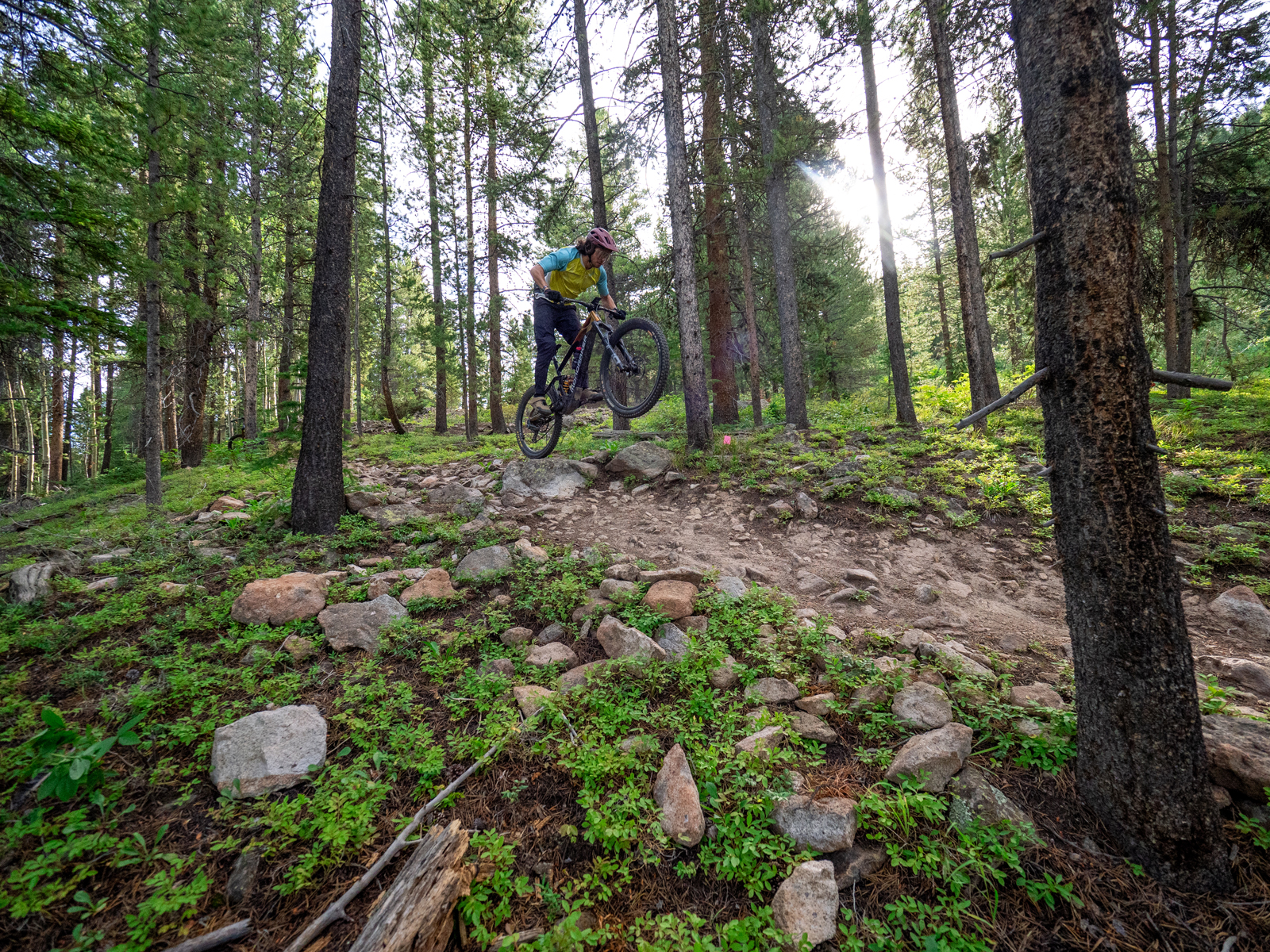
When descending, the Dune XR continues to be an extremely traction-rich bike. Its wheels stay glued to the ground through chunky rock gardens, slippery roots, and loose corners. Combined with excellent traction under braking, this inspires extreme confidence aboard the Dune XR, and I don’t think I found the limits of how fast and aggressively this bike could be ridden throughout our test period. But, the Dune doesn’t require you to be a very skilled or aggressive rider. It’s got a big sweet spot, accepts a variety of body positions, and still feels quite compliant at slower speeds.
Plus, the Dune XR has excellent geometry that complements its surefooted and stable nature on the way down. It has a long reach, somewhat long chainstays, and a slack 63.5º head tube angle that makes for a long wheelbase and stable handling. Its head tube angle is about as slack as I’d want on an eMTB, but it never felt too slack. The Dune XR loves high speeds, chunky terrain, and big features. It truly feels like a bike that is most at home on the most demanding trails, in and outside of a bike park.
That being said, its capability does come at the cost of some playfulness. The Dune XR loves staying glued to the trail so much that it’s actually difficult to get off the ground and into the air. It’s still a relatively light eMTB at 43.6 lbs — which is average for the light-assist eMTB class, but given the burly build and spec on the Dune XR, it’s very impressive. But, it is harder to get into the air than its weight suggests, mostly due to a suspension platform that is designed to be plush and grippy, not responsive and poppy. So, the Dune XR can feel like a bit of a handful on mellow, undulating trails, and it really prefers steep terrain.
Simon: I agree with everything Dylan said about the way the Dune XR descends. Mondraker describes it as a “Super Enduro” bike, and not knowing exactly what that means, I’d still say that it seems pretty accurate. I’m in full agreement with Dylan that the Dune XR is, without a doubt, the most capable descending eMTB I’ve been on to date.
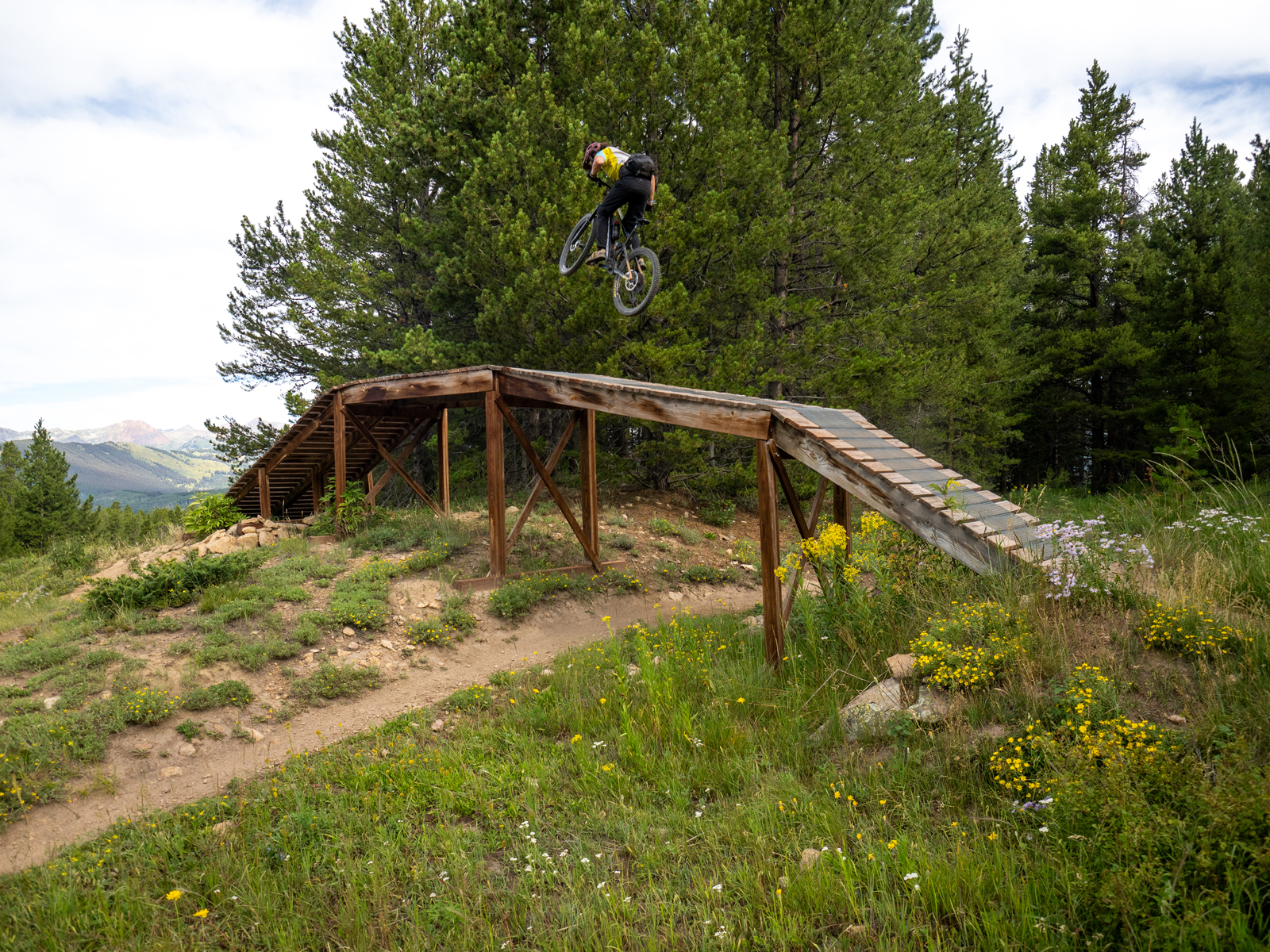
Like Dylan, I didn’t find the limits of the Dune XR, but I also knew I probably wouldn’t given the geometry, travel, and build. But what makes the Dune XR so appealing, is that it doesn’t need to be pushed hard to offer a rewarding experience. It’s the type of bike that inspires progression, but due to its stability and immense traction, it does so in a civilized way without necessarily demanding risks be taken.
The Build
Dylan: I think Mondraker really nailed the build of the Dune XR. Its top-spec Öhlins suspension was a clear highlight for me. Although slightly more difficult to set up off the bat than more familiar options from RockShox or Fox, once dialed, it was a key contributor to the Dune’s damp, planted, and traction-rich feel. I will say that the 457 lb spring that was originally on the Öhlins TTX22M.2 Coil shock on the Large Dune XR was certainly too stiff for me. Once I swapped it for the 411 lb spring that Mondraker recommends for my weight, I was able to fully appreciate the grippy and capable suspension of the Dune XR.
I still think SRAM Transmission drivetrains pair excellently with eMTBs, and that was definitely true on the Dune XR. The SRAM Code Ultimate Stealth brakes on the Dune XR were also excellent, and it was one of the few times that an eMTB did not feel under-braked to me. I’m also a huge fan of the Maxxis Assegai tire up front paired with the Minion DHR out back, and I applaud Mondraker for speccing such a burly tire out back with the Minion DHR being a DH casing tire with the MaxxGrip rubber compound.
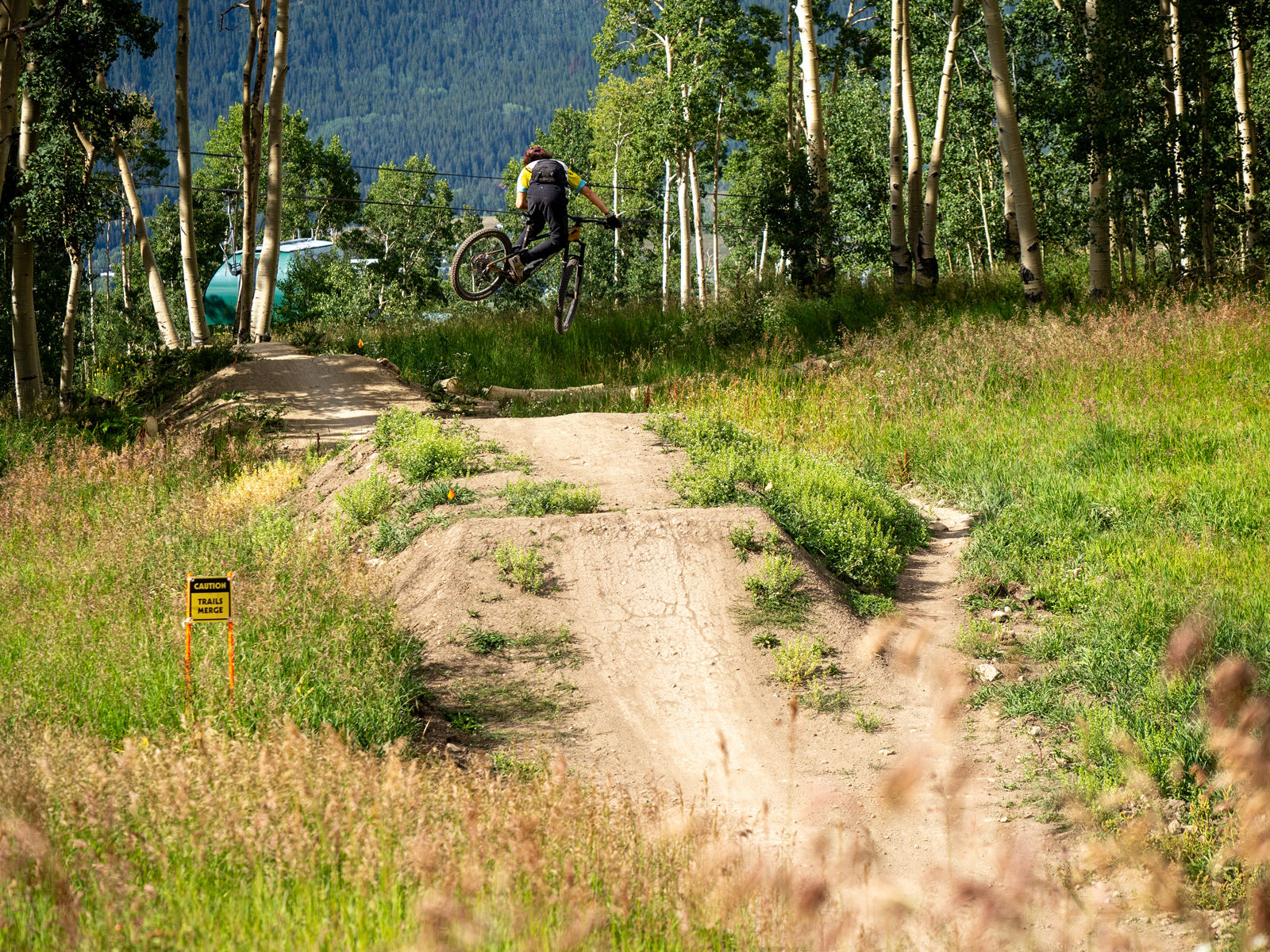
Everything else on the bike was top-notch, with the e*thirteen Grappler Carbon rims also performing well and staying true and taught throughout our test period. It was my first time on these rims, and I was quite happy with them.
Simon: It’s not surprising the $11,999 Dune XR has a fantastic build, and there’s nothing I can think of that would benefit from an upgrade. The Öhlins suspension was a highlight for me, as well as the SRAM XO Eagle AXS Transmission drivetrain, and Maxxis DHR rear tire with the DH casing and sticky rubber compound.
Unfortunately, the 411 Ib spring arrived after I had handed the Dune XR off to Dylan. Even though I’m a bit heavier than him, I’m still squarely in Mondraker’s recommended range for the lighter spring, and I’m confident I would mirror Dylan’s experience on it.
Interestingly, Mondraker specs 170 mm cranks on the size Large and XL Dune XRs — it’s more common to see 165 mm and 160 mm cranks on eMTBs. The Dune XR doesn’t have a particularly low bottom bracket, so the 170 mm cranks don’t have clearance issues when pedaling through technical rocky sections of trail. However, due to the dropper post insertion limitations we touched on earlier, I think 165 mm cranks would have been a better choice since they would add a little bit more wiggle room to lower the seat post if needed.
Drive System
Dylan: We first got on the Bosch SX system on the Norco Fluid VLT 130, and we talked extensively about this light-assist system in that review, so give it a read for a more in-depth look.
To summarize, the Bosch SX system provides tons of power for a light-assist system, and it was a good pairing with the slightly heavier and burly Dune XR. It does feel pretty limited as far as range goes, topping out at around 10-15 miles or 2,500-3,000 feet of elevation gain and loss when staying in the highest “Turbo” mode the entire time. The Dune’s burly and not-so-efficient nature exaggerated these range limitations, but I found it to be adequate for the type of riding the Dune XR encourages.
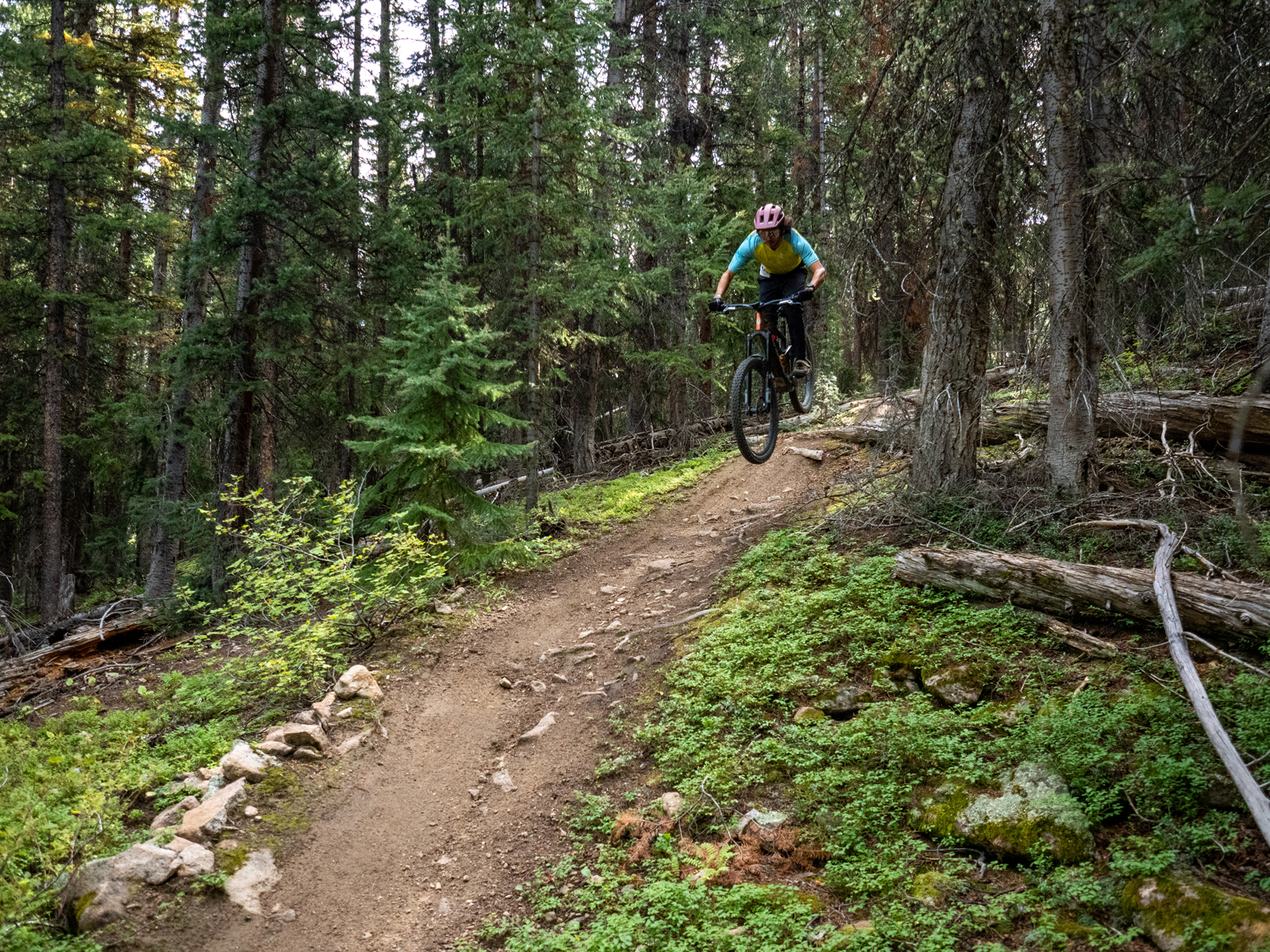
I will say that, when passing the 20 mph cutoff of this Class 1 eMTB motor system, the Dune felt more sluggish than other light-assist bikes. I think the Dune XR itself is more to blame than the Bosch SX system, but it was certainly notable.
Simon: I’m a fan of the Bosch SX motor, and agree with Dylan that it’s a good match for the Dune XR given its focus. I think any of the other available light-assist drive systems would feel underpowered on the Dune XR — which has more to do with its not-great efficiency than its weight (which is pretty average for light-assist eMTBs). The Dune XR has a suspension that excels at keeping the rear tire in contact with the trail and has seemingly limitless traction — but that comes at the price of efficiency, which is an expected trade-off on a bike that puts such a premium on downhill performance.
As Dylan pointed out, the biggest drawback of the SX drive system in the Dune XR is the limited range — the motor’s 600 watts of peak power puts a dent in the 400 wh battery pretty fast. If I owned a Dune XR I would definitely invest in Bosch’s Powermore range extender, which in my opinion is almost mandatory given the Dune XR’s thirst for watt hours.
The Dune XR is the third bike with the Bosch SX drive system I’ve tested, and while I am a fan like I mentioned above, I think the novelty of a lightweight motor capable of the same peak power numbers as full-power motors has worn off a bit. Yes, on paper the Bosch SX puts out a claimed 600 watts, but out on the trail, it doesn’t feel anywhere near as powerful as full-power motors. Torque plays a big part in that, and the Bosch SX’s 55 Nm can’t compete with the 85 Nm of full-power motors like the Shimano EP801 or Bosch CX Performance Line. I notice it most on really challenging technical climbs, where I miss being able to spin a low cadence and still have tons of available torque.
With that said, the SX motor is still the most powerful light-assist motor I’ve been on, and I love how smooth it is while also having a scrappy personality. It is one of the reasons the Dune XR is so light, which is a part of what makes it so good.
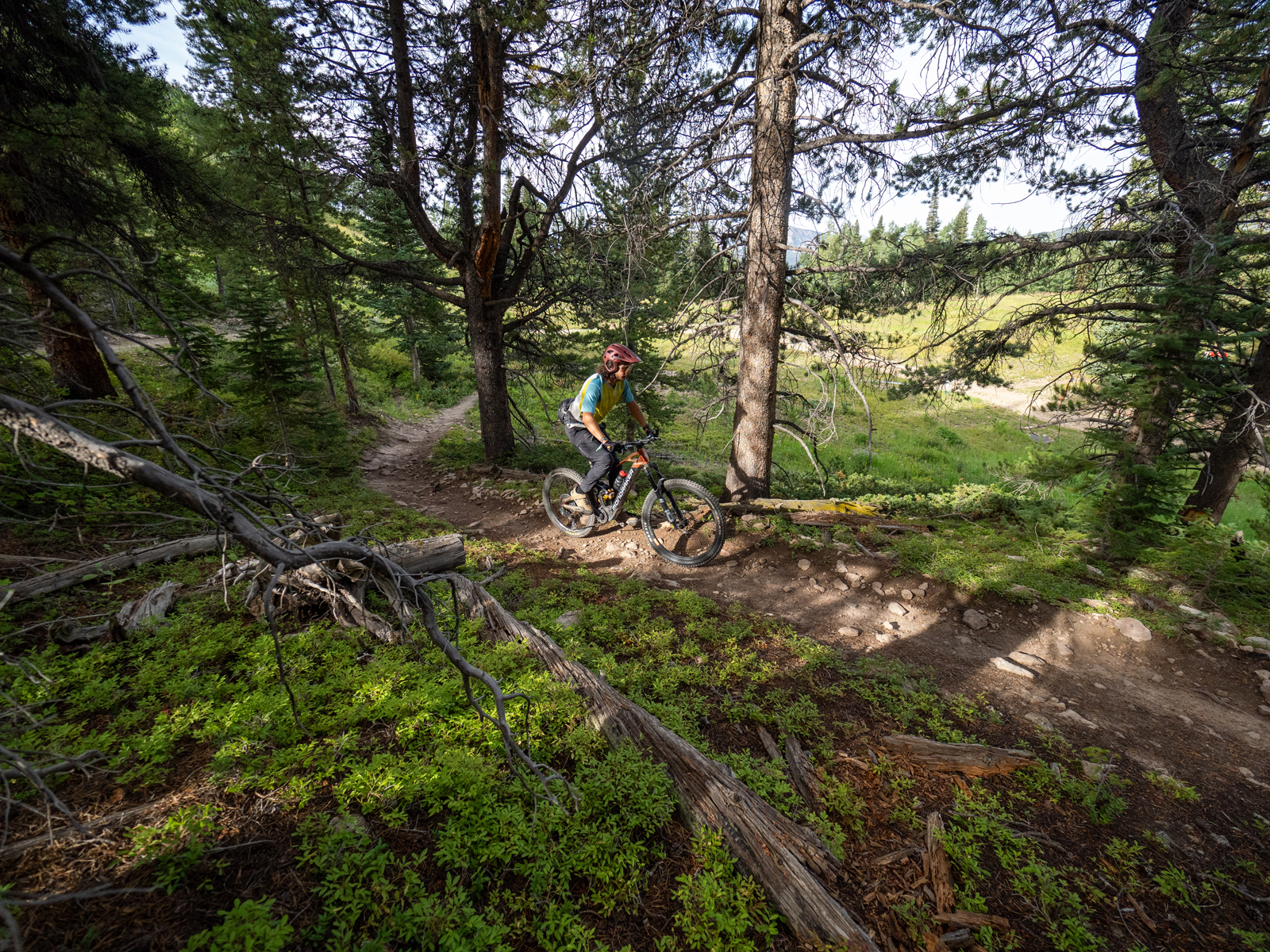
Who’s It For?
Dylan: Riders who want to ride downhill as fast and aggressively as possible and have the steep, chunky terrain to do so are great candidates to be owners of the Dune XR. This bike offers mind-blowing downhill capabilities that make the toughest trails just a bit easier. It really isn’t a good pick for riding playfully on mellower trails that require a dynamic approach, though, and the Dune XR also isn’t the best choice for big eMTB adventures, due to its limited range. But for those who want to do quick winch-and-plummet laps on very gnarly trails, or if you just want an eMTB that can make the difficult and steep trails in your area feel easier, the Dune XR is an excellent choice.
Simon: I think it’s fair to say that the Dune XR has a fairly narrow focus, but for all the reasons Dylan talks about above, and for the right rider in the right conditions, I doubt there’s a better choice than the Dune XR.
Bottom Line
There aren’t many other eMTBs out there that are as capable on the descents as the Mondraker Dune XR, and there are even fewer that are also light-assist eMTBs. This makes the Dune XR an excellent choice for riders who want a very surefooted, traction-rich eMTB that just begs you to go faster, steeper, and bigger.
Deep Dive Comparisons
BLISTER+ members and those who purchase our Digital Access Pass can check out our Deep Dive comparisons linked below. Get our Digital Access Pass to view all our Deep Dives and Flash Reviews, or become a BLISTER+ member today to get access to that and a LOT more, including the best worldwide Outdoor Injury Insurance, exclusive deals and discounts on skis, personalized gear recommendations from us, and much more.

Deep Dive: Mondraker Dune XR
The Mondraker Dune XR is one of the more unique light-assist eMTBs we’ve tested, and as such there aren’t many direct comparisons, so we’re including some full-power eMTBs that match up a bit closer as well.
We compare the Mondraker Dune to the Pivot Shuttle LT, Orbea Wild, Devinci E-Troy, Canyon Torque:ON CF, and Trek Slash+.
Blister’s Flash Reviews and Deep Dives are accessible to those who purchase one of our paid subscriptions
To get our comprehensive Deep Dives and our initial, unfiltered reports on new gear, become a member and receive many other services, deals, and discounts.
If you’re already an active member, please log in.
(If you’re already logged in and a member in good standing and seeing this message in error, please refresh this page in your browser.)

Yea please answer the seatpost insertion question for us. Could be a deal breaker. Also very curious what the Frameset option. Does it come with a fork?
(disclosure – I work for Mondraker) Frameset does not come with a fork. I do recommend demoing one before making a call on the seat post question, as (in my experience from 8 demo events this year across WA, OR, CO, UT and CA) it seems to be a bigger concern “on paper” than on the trail for riders. Not a single person has come back from a demo with a complaint about it that I am aware of, but I understand that may not be true for everyone. Cheers and thanks ~
Im seriously considering one of these but looking at the geo numbers, it really looks like I should size down to a M as those numbers are much closer, or still longer, than my S4 Stumpjumper Evo which already feels a little long to me. I’m 6′ 190 lbs. I’m sure size wise that would feel more comfortable as I had a M Trek Fuel before my Stevo and though a little small, I don’t like the feel of being stretched out too far and the M Dune would be much larger than the Trek.
I’m also wondering if that would make it more agile on tighter trails as many of the reviews say that the Dune is great, but not very nimble. The other bike I’m looking at is a Large Heckler SL (also has geo data in line with the M Dune) and I’m wondering if a M Dune would gain some of the agility and playfulness that reviewers speak of about the Heckler SL. The Bosch SX seems a lot more reliable than the Fazua and is more than enough power as I will almost always use it in the lowest setting.
Hey Dane, I’m roughly the same height as you, and I got along very well with the size Large. Dylan Wood, who also rode the Dune XR, is a little shorter (5′ 10″) and also liked the fit on the size Large — I would encourage a test ride before committing to the size Medium.
While we didn’t test a size Medium, I’m fairly confident it will have a very similar on-trail feel to the size Large. I think a lot of the ride characteristics are coming from the suspension kinematics and build spec. I think the Dune XR is going to be planted and stable, and not particularly playful in all sizes — with that said, I have yet to ride a better bike for winch and plummet style riding in steep, gnarly terrain.
Despite some geometry similarities, the Heckler SL and Dune XR are very different. The Heckler SL is a much more versatile all-around light-assist eMTB, while the Dune XR, like I mentioned above, is very much a downhill-focused eMTB.